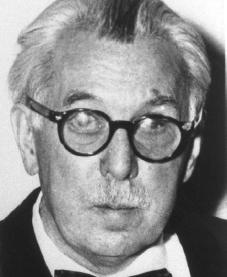James Thurber Biography
Born: December 8, 1894
Columbus, Ohio
Died: November 2, 1961
New York, New York
American writer and artist
James Thurber was an American writer and artist. One of the most popular humorists (writers of clever humor) of his time, Thurber celebrated in stories and in cartoons the comic frustrations of eccentric yet ordinary people.
Early life in Ohio
James Grove Thurber was born on December 8, 1894, in Columbus, Ohio, to Charles Leander and Mary Agnes Thurber. The family soon moved to Virginia where Charles was employed as a secretary to a congressman. While playing with his older brother, Thurber was permanently blinded in his left eye after being shot with an arrow. Problems with his eyesight would plague Thurber for much of his life. After Charles's employer lost a reelection campaign, the Thurbers were forced to move back to Ohio. Thurber attended the local public schools and graduated high school with honors in 1913. He went on to attend Ohio State University—though he never took a degree—and worked for some years afterwards in Ohio as a journalist.
Life in New York City
Thurber moved to New York City in 1926 and a year later he met writer E. B. White (1899–1985) and was taken onto the staff of the New Yorker magazine. In collaboration with White he produced his first book, Is Sex Necessary? (1929). By 1931 his first cartoons began appearing in the New Yorker. These primitive yet highly stylized characterizations included seals, sea lions, strange tigers, harried men, determined women, and, most of all, dogs. Thurber's dogs became something like a national comic institution, and they dotted the pages of a whole series of books.
Thurber's book The Seal in the Bedroom appeared in 1932, followed in 1933 by My Life and Hard Times. He published The Middle-aged Man on the Flying Trapeze in 1935, and by 1937, when he published Let Your

Reproduced by permission of
The Last Flower appeared in 1939; that year Thurber collaborated with White on a play, The Male Animal. The play was a hit when it opened in 1940. But this was also the year that Thurber was forced to undergo a series of eye operations for cataract and trachoma, two serious eye conditions. His eyesight grew steadily worse until, in 1951, it was so weak that he did his last drawing. He spent the last decade of his life in blindness.
Later years
The last twenty years of Thurber's life were filled with material and professional success in spite of his handicap. He published at least fourteen more books, including The Thurber Carnival (1945), Thurber Country (1953), and the extremely popular account of the life of the New Yorker editor Harold Ross, The Years with Ross (1959). A number of his short stories were made into movies, including "The Secret Life of Walter Mitty" (1947), which is also regarded as one of the best short stories written in the twentieth century.
Thurber died of pneumonia (an infection of the lungs) on November 2, 1961, just weeks after suffering a stroke. Thurber left behind a peculiar and unique comic world that was populated by his curious animals, who watched close by as aggressive women ran to ground apparently spineless men. But beneath their tame and defeated exteriors, Thurber's men dreamed of wild escape and epic adventure and, so, in their way won out in the battle of the sexes.
For More Information
Bernstein, Burton. Thurber: A Biography. New York: Dodd, Mead, 1975. Reprint, New York: Arbor House, 1985.
Fensch, Thomas. The Man Who Was Walter Mitty: The Life and Work of James Thurber. The Woodlands, TX: New Century Books, 2000.
Grauer, Neil A. Remember Laughter: A Life of James Thurber. Lincoln: University of Nebraska Press, 1994.
Kinney, Harrison. James Thurber: His Life and Times. New York: H. Holt, 1995.
Thurber, James. My Life and Hard Times. New York: Harper, 1933. Reprint, New York: Perennial Classics, 1999.
I think his wit is unique.
After reading a wit my psychological mind experienced
release phenomenon.
I will read as much as possible of his writings
R.Surapaneni.